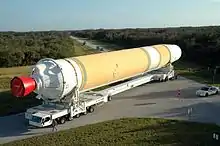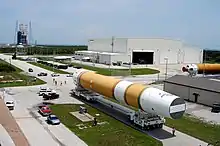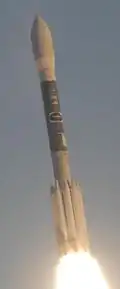Common Booster Core
The Common Booster Core (CBC) is an American rocket stage, which is used on the Delta IV rocket as part of a modular rocket system. Delta IV rockets flying in the retired Medium and Medium+ configurations each used a single Common Booster Core as their first stage, while the Heavy configuration uses three; one as the first stage and two as boosters.[1] The Common Booster Core is 40.8 metres (134 ft) long, has a diameter of 5.1 metres (17 ft) and is powered by a single RS-68 engine burning liquid hydrogen and liquid oxygen.[2]
 Delivery of the CBC used as the first stage of Delta 342, which launched GOES 14 | |
| Manufacturer | Boeing (1998–2006) United Launch Alliance (2006—) |
|---|---|
| Country of origin | United States |
| Used on | Delta IV (stage 1) Delta IV Heavy (boosters) |
| General characteristics | |
| Height | 40.8 m (134 ft) |
| Diameter | 5.1 m (17 ft) |
| Gross mass | 226,400 kg (499,100 lb) |
| Delta IV CBC | |
| Engines | 1 RS-68 |
| Thrust | 3,312.76 kN (744,740 lbf) |
| Burn time | 367 s |
| Fuel | LOX/LH2 |

The first static test firing of a Common Booster Core was conducted on 17 March 2001, and the final test of the initial programme was conducted on 6 May.[3] Testing was conducted using Test Stand B-2 of the Stennis Space Center,[4] a facility originally constructed for testing of the first stages of Saturn V rockets during the 1960s. The first launch of a Common Booster Core was the maiden flight of the Delta IV, which was launched from Space Launch Complex 37B at the Cape Canaveral Air Force Station on 20 November 2002.[5]
The first flight of the Delta IV Heavy, featuring three Common Booster Cores, was conducted on 21 December 2004. On this flight all three CBCs malfunctioned, cutting off prematurely due to cavitation in their oxidizer lines, and resulting in the rocket reaching a lower orbit than that which had been planned. In response to the failure, additional pressure valves were installed on future launches.[6]
As of December 2014, the Delta IV has made 28 flights; twenty in Medium and Medium+ configurations, and eight in the Heavy configuration, resulting in a total of 44 Common Booster Cores being launched.[7]
The CBCs are manufactured in United Launch Alliance's 1,500,000-square-foot (140,000 m2) manufacturing facility in Decatur, Alabama and then transported by the M/V Delta Mariner to either Vandenberg Air Force Base or Cape Canaveral Air Force Station where they are integrated with the spacecraft and other components such as strap-on boosters and a Delta Cryogenic Second Stage.[8]
See also
- Universal Rocket Module, the Russian Angara common core.
- Falcon Heavy, the SpaceX Falcon 9 multi-core variant.
References
- "Countdown 101: Delta IV". NASA. Retrieved 10 September 2010.
- Wade, Mark. "Delta RS-68". Encyclopedia Astronautica. Archived from the original on 11 May 2010. Retrieved 10 September 2010.
- "Delta 4 Core Booster Rocket Engine Completes Test Program". Space.com. 9 May 2001. Archived from the original on 29 June 2009. Retrieved 10 September 2010.
- "Stennis Space Center Tours and Briefings on Boeing Rocketdyne's RS-68 engine for the Delta IV". SpaceRef. 30 October 2002. Retrieved 10 September 2010.
- McDowell, Jonathan. "Launch Log". Jonathan's Space Page. Retrieved 10 September 2010.
- Ray, Justin (10 April 2005). "Fixes ordered across Boeing's Delta 4 rocket line". Delta Launch Report. Spaceflight Now. Retrieved 10 September 2010.
- Kyle, Ed. "Delta IV Launch Record". Space Launch Report. Retrieved 6 February 2015.
- Boeing: Multimedia - Image Gallery - Delta IV Launch Vehicle Manufacturing - Decatur, Alabama Archived 2007-02-03 at the Wayback Machine
